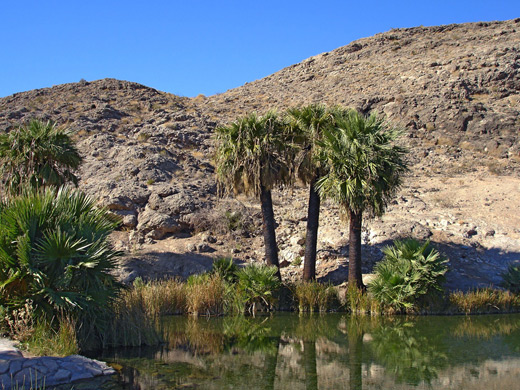Highlights:
Large, natural, warm-water spring at the foot of the Muddy Mountains, lined by non-native California fan-palms. A low dam forms a shallow, 80 foot-wide pool, and the place is popular for picnics, paddling and bird-watching
Location:
Northshore Road (Hwy 167), 51 miles north of the visitor center
Seasons:
All year
Rogers Spring is one of the largest and most easily accessed water sources in Lake Mead National Recreation Area, situated right beside Northshore Road (Hwy 167), 51 miles north of the visitor center, in an otherwise barren area at the foot of the Muddy Mountains, 2.5 miles from the lakeshore. The spring is natural, producing around a thousand gallons of clear, 82°F, carbonate-rich water each minute, associated with a major fracture in the bedrock, the Rogers Spring Fault.
The ultimate source is thought to be the mountains around Ely, from where the waters travel slowly underground through an aquifer; the fault results in younger, more impermeable rocks being displaced upwards relative to the older dolomite and limestone around the aquifer, diverting the flow towards the surface.
The ultimate source is thought to be the mountains around Ely, from where the waters travel slowly underground through an aquifer; the fault results in younger, more impermeable rocks being displaced upwards relative to the older dolomite and limestone around the aquifer, diverting the flow towards the surface.
Introduction
This spring has been subject to several modifications over the last century, including an irrigation project linking it with the smaller Blue Point Spring, one mile northeast. The waters now are impounded by a low earthen dam to form a shallow pool about 80 feet across, lined by non-native California fan palms (washingtonia filifera), flourishing despite several attempts by the park service to remove them, in order to make the environment more natural. The palms though greatly enhance the photogenicity, contrasting with the clear water and the arid, desert surroundings.
In summer, heat from the sun raises the water temperature in the pool by up to eight degrees. The spring is popular for picnics, for bird watching, for paddling and perhaps for swimming, though this is not advisable due to presence of naegleria fowleri, a harmful amoeba, and the waters are in any case only just deep enough, around three feet in the middle.
Rogers Spring
A very short side road leads to a parking area beside the spring, which is overlooked by three shade ramadas with tables, benches and bbq grills. Several palms grow on the west side of the pool, with rather more along the outflow stream (Rogers Wash). Other poolside vegetation includes saltcedar and southern cattail, while a bushy, riparian corridor extends all the way to the lake, and is over 100 feet wide in some places. The sandy-floored pool contains several species of fish, most or all of which are non-native, plus two species of turtle; spiny softshell (probably native) and red-eared slider (introduced).
All Contents © Copyright The American Southwest | Comments and Questions | Contribute | Affiliate Marketing Disclosure | Site Map





